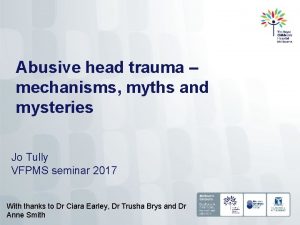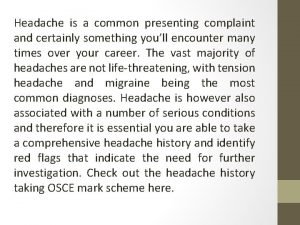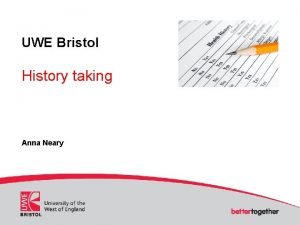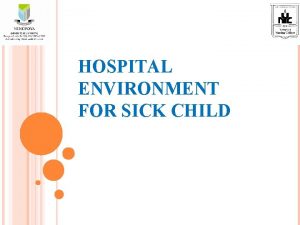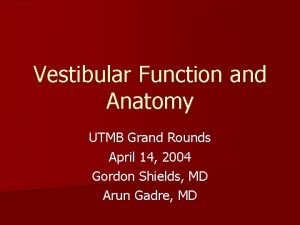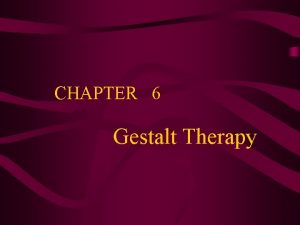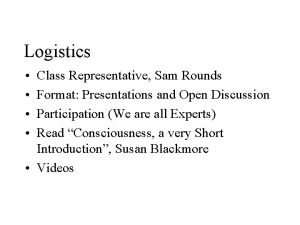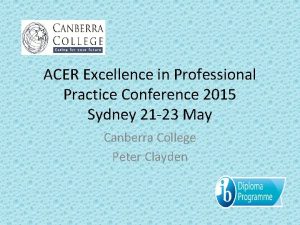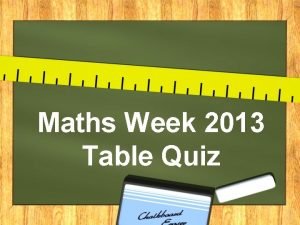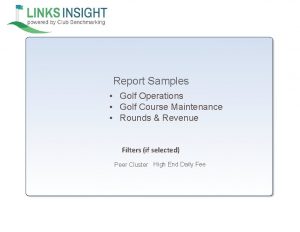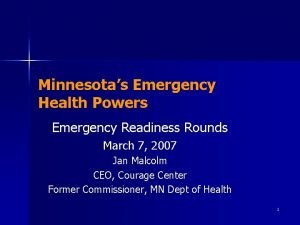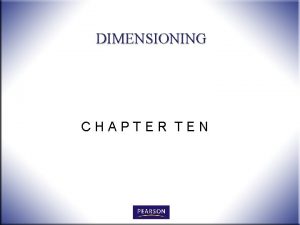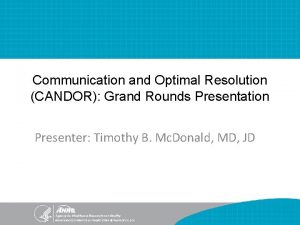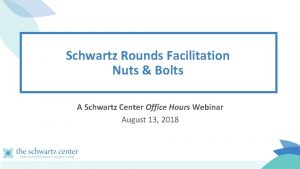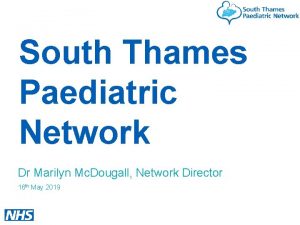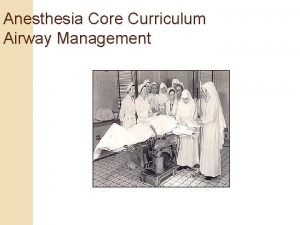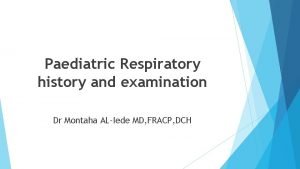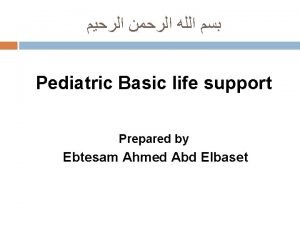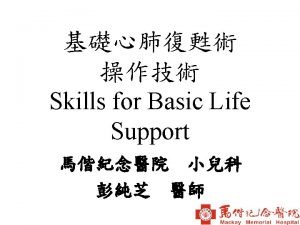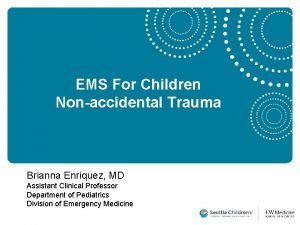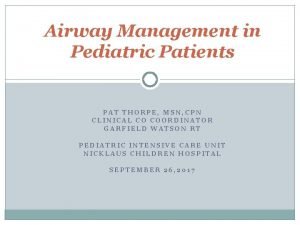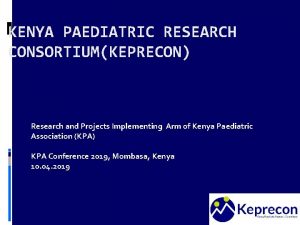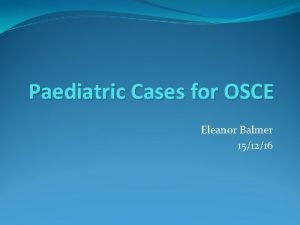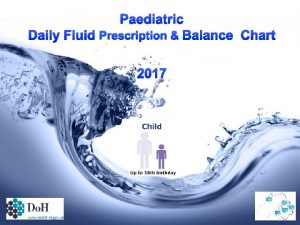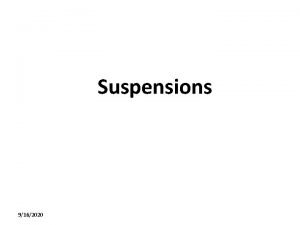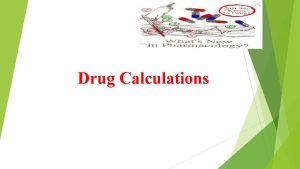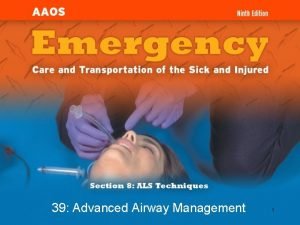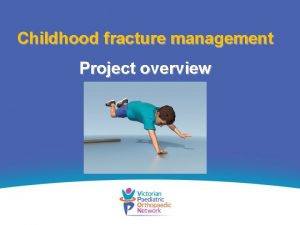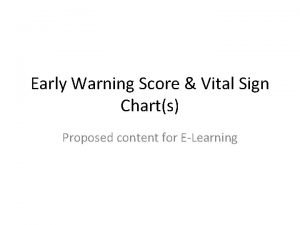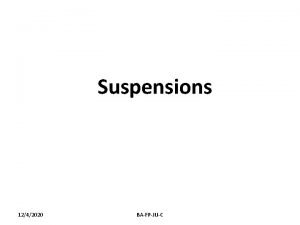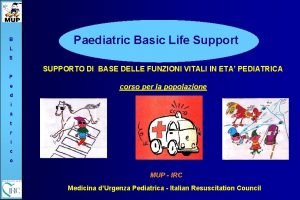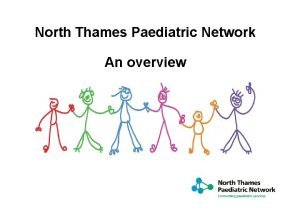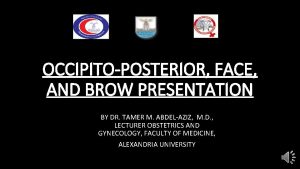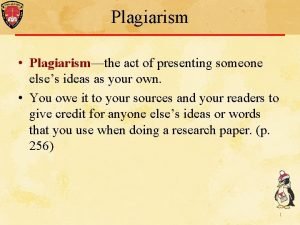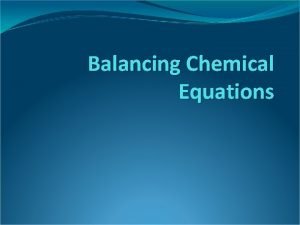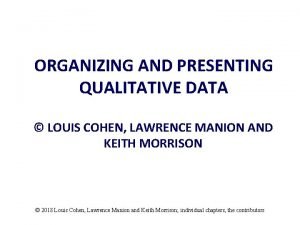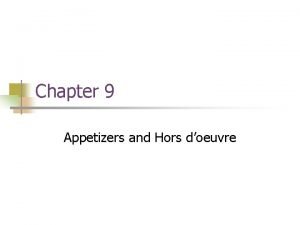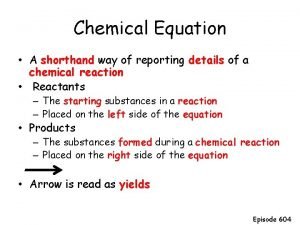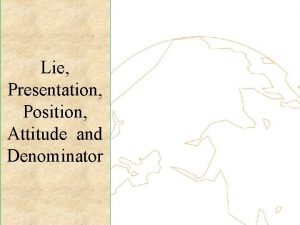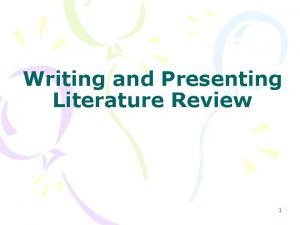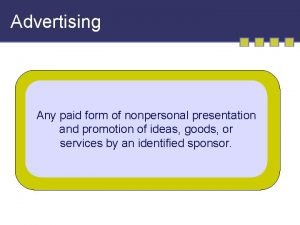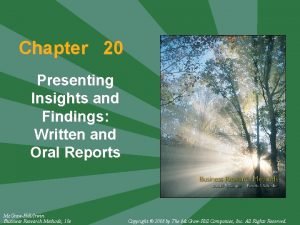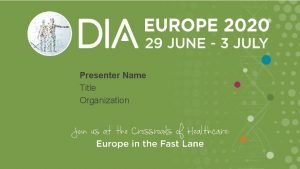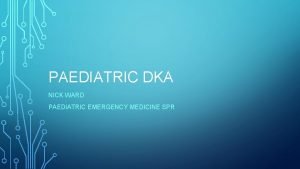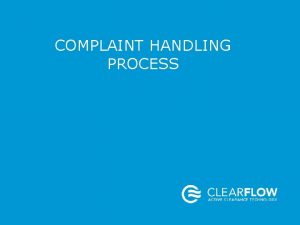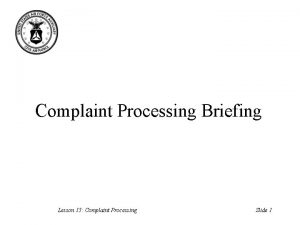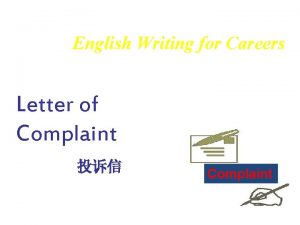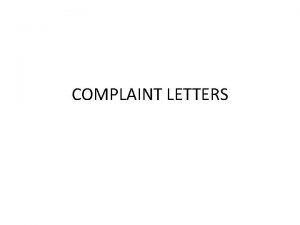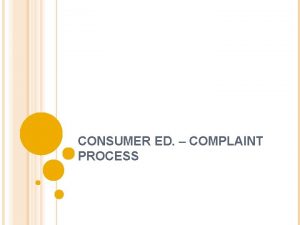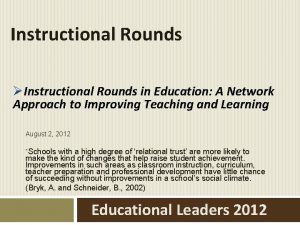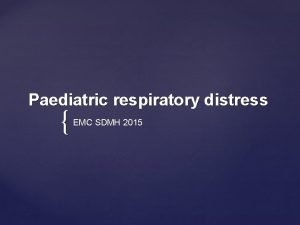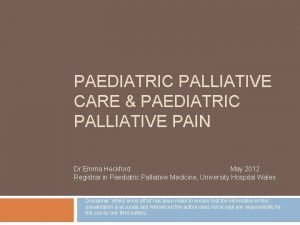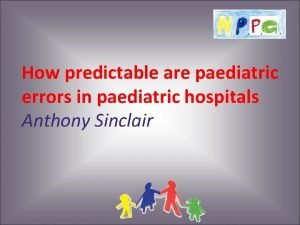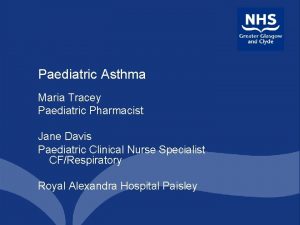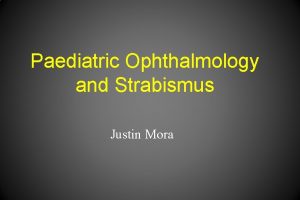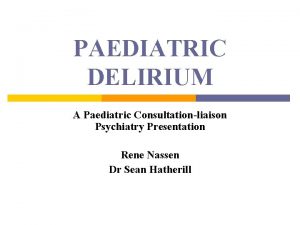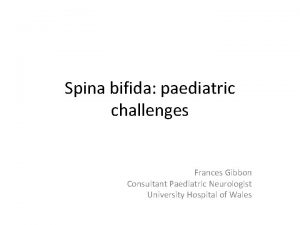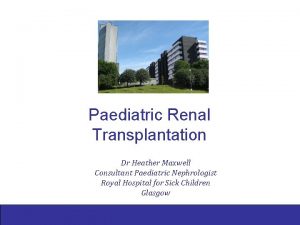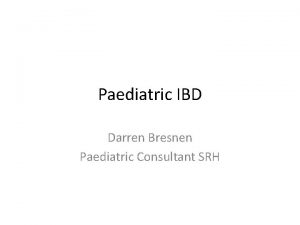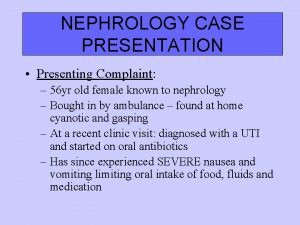Paediatric Emergency Rounds Presenting Complaint My child has
































































- Slides: 64

Paediatric Emergency Rounds Presenting Complaint: “My child has a RASH” Kelly Millar

Overview of Topics 1. Varicella in the immunocompromised host 2. Fever and petechiae 3. Acute exfoliating conditions

CASE 1 • 3 yo on prednisone (2 mg/kg/d) for nephrotic syndrome – 5 yo sibling just diagnosed with chicken pox – No prev Varivax, no hx of CP infection What would you do? • • • A) B) C) D) E) wait and see oral acyclovir IV acyclovir VZIG call ID!? !

CASE 2 • 3 yo on prednisone (2 mg/kg/d) for nephrotic syndrome – just diagnosed with chicken pox – First lesion noted in past 24 hours What would you do? • • • A) B) C) D) E) wait and see oral acyclovir IV acyclovir VZIG call ID!? !

CASE 3 • 3 yo on flovent (125 ug) 2 puffs BID for asthma maintenance – Just diagnosed with chicken pox – First lesion noted in past 24 hours What would you do? • What if this child had received a 5 day course of prednisone (2 mg/kg) 3 weeks ago? • • • A) B) C) D) E) wait and see oral acyclovir IV acyclovir VZIG call ID!? !

How well are physicians doing? • General practice survey of the management of chickenpox: appropriate targeting of antiviral therapy. Shepherd et al. Family Practice (2001) 18(3): 249 -52 • Only 61. 8% used antivirals when clear indication to do so • 32. 6% used antivirals when not indicated

Varicella Exposure • Defined as household, play, or classroom contact with person who has varicella or who develops varicella within 48 hours • transmitted to 85 -90% of susceptible household contacts • May be acquired after close physical contact with person with zoster

Varicella Prophylaxis Strategies 1. Varivax 2. VZIG 3. Acyclovir?

Varicella Prophylaxis - Varivax • • Live attenuated Seroconversion rates: • • Children: > 95% after 1 dose >13 yrs: 80% after 1 dose, 99% after 2 doses 3 -5% develop localized lesions, another 3 -5% generalized lesions (rarely transmissable) Evidence for post-exposure prophylaxis if given within 72 hrs post-exposure

Varicella Prophylaxis - VZIG • Highly effective when given within 96 hrs of exposure • 10 -15% have mild breakthrough infection • Prolongs incubation period (if admitted, must be isolated for 35 days post exposure)

Varicella Prophylaxis - Acyclovir • 3 recent studies on po acyclovir prophylaxis for healthy household contacts: – Acyclovir given for 5 -7 days starting on day 7 postexposure (coincides with viremia) – Decreases the rate of clinical varicella by 65% – Problem: Low varicella antibody titres • ? Protection against reinfection • ? Predisposition to early zoster

Varicella Prophylaxis - Acyclovir • No data for efficacy in immunocompromised patients – ? Possible role if VZIG unavailable or if patient presents > 96 hrs post-exposure

Who needs post-exposure prophylaxis? • No history of varicella PLUS one of: 1. Newborns whose mothers developed lesions from 5 days prior to 48 hrs post delivery 2. Pregnant women 3. Immunocompromised – high dose steroids in past 30 days, chemotherapy, BMT, immunosuppressives, congenital cellular immunodeficiencies, HIV

What about steroids? • Low dose: – < 1 mg/kg/day prednisolone or equivalent – < 20 mg/day total prednisolone or equivalent – Inhaled steroids • High Dose: – > 1 mg/kg/day or > 20 mg per day total of prednisolone or its equivalent – Beware of anabolic steroid users

What PEP should be used? In the immunocompromised? • If present within 96 hours post-exposure: – GIVE VZIG • If present after 96 hours post-exposure: – Consider acyclovir • Possible role for combined VZIG + po acyclovir In the healthy patient? • May offer Varivax within 72 hours of exposure

Treatment of Varicella: Who should receive acyclovir? Patient population Low risk Healthy children ≤ 12 yrs Treatment None (? 2°) Increased > 12 years, low dose steroids, Consider risk ASA, pregnancy, chronic skin po acyclovir * or lung disease High risk High dose steroids in past 30 d IV acyclovir * chemo, BMT, babies <2 wks, immunosuppressives, HIV, congenital immunodeficiency * Initiate therapy within 24 hours of onset of rash

Treatment of Varicella: Who should receive acyclovir? • IV therapy should also be given to all severely ill patients regardless of risks • Severe disease = pneumonitis, hepatitis, encephalopathy, DIC, SIADH • Visceral dissemination is heralded by high fever, extensive rash, & severe abdominal or back pain

Why not use acyclovir for everyone? • Reduces mean # lesions from 347 to 294 • Fever defervesces 1 day earlier • No reduction in 2° bacterial infections, pneumonitis or cerebellitis • Does not reduce household transmission • S/E – headache, nausea, vomiting, rash • 1% - acute encephalopathy – ↑ risk in underlying neuro/renal disorders

Herpes Zoster • IV acyclovir for severely immunocompromised • PO acyclovir for mildly immunocompromised • Involvement of opthalmic branch of trigeminal: – po acyclovir (IV if < 2 years of age) – Optho consult

CASE 1 • 3 yo on prednisone (2 mg/kg/d) for nephrotic syndrome – 5 yo sibling just diagnosed with chicken pox – No prev Varivax, no hx of CP infection What would you do? • • • A) B) C) D) E) wait and see oral acyclovir IV acyclovir VZIG call ID!? !

CASE 1 • 3 yo on prednisone (2 mg/kg/d) for nephrotic syndrome – 5 yo sibling just diagnosed with chicken pox – No prev Varivax, no hx of CP infection What would you do? • • • A) B) C) D) E) wait and see oral acyclovir IV acyclovir VZIG call ID!? !

CASE 2 • 3 yo on prednisone (2 mg/kg/d) for nephrotic syndrome – just diagnosed with chicken pox – First lesion noted in past 24 hours What would you do? • • • A) B) C) D) E) wait and see oral acyclovir IV acyclovir VZIG call ID!? !

CASE 2 • 3 yo on prednisone (2 mg/kg/d) for nephrotic syndrome – just diagnosed with chicken pox – First lesion noted in past 24 hours What would you do? • • • A) B) C) D) E) wait and see oral acyclovir IV acyclovir VZIG call ID!? !

CASE 3 • 3 yo on flovent (125 ug) 2 puffs BID for asthma maintenance – Just diagnosed with chicken pox – First lesion noted in past 24 hours What would you do? • What if this child had received a 5 day course of prednisone (2 mg/kg) 3 weeks ago? • • • A) B) C) D) E) wait and see oral acyclovir IV acyclovir VZIG call ID!? !

CASE 3 • 3 yo on flovent (125 ug) 2 puffs BID for asthma maintenance – Just diagnosed with chicken pox – First lesion noted in past 24 hours What would you do? • What if this child had received a 5 day course of prednisone (2 mg/kg) 3 weeks ago? • • • A) B) C) D) E) wait and see oral acyclovir IV acyclovir VZIG call ID!? !

Fever and Petechiae In prospective cohort studies, 1. 8% of children with fever > 38° have petechiae

CASE • An 18 mo old child presents with a fever of 38. 9° and is noted by nursing staff to have petechiae. Remaining vitals are normal. • You assess the child to be content and nontoxic in appearance. You note mild URTI Sx and multiple petechiae on the chest and arms. The remainder of your exam is unremarkable. • How will you proceed?

• Evaluation of febrile children with petechial rashes: is there consensus among pediatricians? DG Nelson et al. Ped Inf Dis J 1998; 17: 1135 -40. management is highly variable!

Why do we worry? • Fever and petechiae may be a harbinger of septicemia • In the past, many authorities recommended blood cultures, lp, and admission for empiric IV antibiotics until cultures returned! • These recommendations where based on published series of in-patients with fever and petechiae where invasive bacteria where detected at rates of up to 17% • Probable selection bias as examined only in-patients

Fever and Petechiae - Etiology

Who needs further investigation and treatment? • Toxic, hypotensive, significant lethargy or irritability Straightforward • Well appearing child not so easy

Can we be more selective in the ED? Incidence of bacteremia in infants and children with fever and petechiae. Mandl et al. J Pediat 1997; 131: 398 -404. • • Prospective cohort study of all children ≤ 18 yrs presenting to the ED with fever and petechiae over an 18 mo period N = 411 Clinical features recorded: general appearance, number of petechiae, position of petechiae, whether a mechanical cause for petechiae was present, purpura Labs recorded: CBC, cultures, coags, CSF

Mandl et al – Children’s Hosp, Boston CBC (97%) Culture (95%) Coags (64%) LP (53%) Fever & petechiae (418) Excluded (7) Included (411) Admitted (63%) Sepsis (N=8) 2 Meningococcus 1 Gp A Strep 3 no growth* 2 pneumococcus D/C home (37%) Antibiotics (66%) Sepsis (0%)

Mandl et al – Children’s Hosp, Boston Diagnostic predictors for invasive bacteremia Sensitivity Specificity PPV 1. 00 0. 88 0. 11 NPV 1. 00 0. 64 0. 05 1. 00 pet. below 1. 00 nipples 0. 40 0. 02 1. 00 purpura 0. 83 0. 97 0. 31 0. 99 prolonged INR 0. 67 0. 98 0. 40 0. 99 ill appearing ab. N WBC 1. 00

Mandl et al – Children’s Hosp, Boston • “well appearing children with petechiae, but no purpura and normal WBC and INR and exceedingly unlikely to have serious invasive bacteremia” • No children with petechiae limited to above the nipple line had bacteremia

Do other out-patient studies agree? • The management of fever and petechiae: making sense of rash decisions. Brogan & Raffles. Arch Dis Child 2000; 83: 506 -7. • Retrospectively and prospectively assessed the performance of a 5 factor screening test (N=55) • Factors = shock, lethargy, irritability, abnormal WBC, elevated CRP • 5 patients had bacterial sepsis • Sens 100%, Spec 60%, PPV 20%, NPV 100%

What about petechiae without fever? • LC Wells et al Arch Dis Child 2001 • • • Prospective cohort study of children aged <16 yrs presenting to the PED with non-blanching rash over a 12 month period N=233, 15 excluded N = 218 11% bacteremia (all meningococcus)

Wells et al - Nottingham Sensitivity Specificity PPV NPV ill appearing 79 (100) 81 (88) 35 (11) 97 (100) ab. N WBC 58 (100) 56 (64) 14 (5) 91 (100) Rash below nipple line purpura 100 (100) 38 (40) 17 (2) 100 (100) 83 (83) 88 (97) 47 (31) 98 (99) prolonged INR 58 (67) 96 (98) 67 (40) 94 (99) *Fever > 37. 5°: Sensitivity = 79%, NPV = 95

How should we approach the child with petechiae? • Clinical Risk Factors: – Toxic appearance, lethargy, irritability – Petechiae below the nipple line, purpura • Laboratory Risk Factors: – Abnormal WBC (<5000, >15000) – Elevated INR

How should we approach the child with petechiae? Safe approach: Draw CBC, coags and culture (+/- lp as clinically indicated) • if no risk factors, may D/C home (may consider a 4 hour observation period) • If any positive risk factors, admit for IV antibiotics pending culture results In a well-appearing child with no purpura and petechiae limited to the SVC area (with a plausable mechanism – ie. vomiting/coughing) – an argument could be made for not doing bloodwork

Acute Exfoliating Conditions • Toxic Epidermal Necrolysis (TEN) – Incidence ~ 1. 3 per million • Staph Scalded Skin Syndrome (SSSS) – Incidence ~ unknown

Toxic Epidermal Necrolysis (TEN) • A life-threatening, exfoliating disease of the skin and mucous membranes • Hallmark is full-thickness necrosis of the epidermis with separation at the dermoepidermal junction

Relationship of TEN to other Exfoliating Conditions • Controversal relationship to: – Erythema multiforme minor – Erythema multiforme major – Stevens-Johnson syndrome • Unclear if TEN is distinct entity or severe form of EM major or SJS

A Spectrum of Illness? TEN SJS EM Major Erythema Multiforme Minor

Erythema Multiforme Minor • Erythematous, target-like lesions, occasionally with bullae, symmetrically involving extensor surfaces of limbs, palms and soles

EM Minor • Cause – hypersensitivity reaction (HSV, drugs) • Course –benign, self-limited, usually resolves in 5 – 15 days • Treatment – oral antihistamines and topical steroids may provide symptomatic relief • Skin tenderness is not typical and should alert to possibility of early TEN

Erythema Multiforme Major • Also thought to be a hypersensitivity reaction • As with EM minor, but with involvement of ≥ 2 mucosal surfaces (precedes rash by 1 -2 days) • Pronounced constitutional symptoms common

Stevens-Johnson Syndrome • Is SJS is separate entity from EM major? • Some feel SJS is a distinct entity as the rash is more erythematous and less acral than EM major • EM major is more commonly triggered by infections and SJS by drugs

SJS vs TEN • Unsure if on same spectrum or distinct diseases • Some use %BSA to define with: <10% = SJS >30% = TEN • Histologically SJS has a much higher density cell infiltrate (T-lymphocytes) vs TEN (low density macrophages and dendrocytes)

TEN - Pathogenesis • Majority of cases are likely adverse drug reactions (foreign antigen response) • Mean time from drug to onset = 13. 6 days • Higher risk drugs – NSAIDS [38%] – Antibiotics [36%] (sulfonamides) – Anticonvulsants [24%] (phenobarb, lamotrigene) – Corticosteroids [14%]

TEN - Clinical Features • Initial symptoms (1 -3 days) – Fever (100%) – Conjuctivitis (32%) – Pharyngitis (25%) – Pruritis (28%) – Headache, myalgias, arthralgias, vomiting, and diarrhea may occur

TEN - Clinical Features: Mucosal Involvement • Erosive mucosal lesions (1 -3 days before skin eruption) occur in 97% – Oral (93%) – Ocular (78%) – Genital (63%) – anal

TEN - Clinical Features: Skin Eruption • Burning / painful skin rash • Usually begins on face / upper trunk • Begins as one of: – Diffuse erythema – Irregular bullae – Poorly defined dusky or erythematous macules • Scalp usually spared

TEN - Disease Progression • Skin may develop flaccid bullae or may detach irregularly • Skin lesions progress and extend for 3 -4 days (may progress rapidly over hours) • Mean BSA involvement 70%

Nikolski’s Sign = separation of the epidermis from the dermis by rubbing skin between the lesions

Multisystem Involvement • GI - Mucosal sloughing in esophagus (dysphagia, GI bleeding) • Resp - Tracheal/bronchial erosions (Respiratory decompensation) • Renal - Glomerulonephritis • Profound fluid and electrolyte disturbances

Challenges • Fluid losses • Infection – Staph. aureus, Psuedomonas aeruginosa • Impaired thermoregulation • Increased energy expenditure

Therapy - General • Transfer to a burn center increases survival • General management principles similar to burn management

? Medical Therapy • Steroids are controversial – Appears to be no survival benefit – No decrease in ocular complications – Possible increased risk of death from sepsis • Immunomodulators: No clear evidence for plasmapheresis, cyclophosphamide or cyclosporin • IVIG – promising (increased survival shown in adults)

Mortality • Wide range in published case series • Death most common from systemic infection • Poor prognostic factors: – Extremes of age – Increased %BSA involvement – Elevated serum BUN – Neutropenia

Staph Scalded Skin Syndrome • SSSS is a distinct entity but may be difficult to distinguish clinically • Both have rapidly evolving exfoliation and conjunctival involvment • SSSS has no initial target lesions, the erosions are more superficial and less weepy, oropharyngeal lesions are rare • Skin biopsy is helpful: (SSSS = intraepidermal separation)

Staph Scalded Skin Syndrome • • Typically presents in children < 6 years > 60% occur in children < 2 years Caused by exotoxin-producing staph Children lack immunity to toxins and have slower renal clearance of toxin

Staph Scalded Skin Syndrome • Abrupt onset – fever, skin tenderness, rash • Often first seen as erythema and crusting around the mouth • Rash spreads down the body • Bullae formation and desquamation follow

Staph Scalded Skin Syndrome • Usually penicillin resistant strains • Treat with penicillinase-resistant penicillin (IV) • Steroids are contraindicated • 4% mortality (mostly newborns)
 Presenting complaint
Presenting complaint Presenting complaint
Presenting complaint Pain history taking
Pain history taking Definition of sick child
Definition of sick child Utmb grand rounds
Utmb grand rounds Breech face gun
Breech face gun Five layers of neurosis
Five layers of neurosis Sam rounds
Sam rounds How do you round 75 to the nearest 10
How do you round 75 to the nearest 10 Harvard instructional rounds
Harvard instructional rounds A is an odd number which rounds to 100 000
A is an odd number which rounds to 100 000 Quality teaching rounds coding sheet
Quality teaching rounds coding sheet Christmas table quiz seomra ranga
Christmas table quiz seomra ranga Duke family medicine and community health
Duke family medicine and community health Maintenance rounds
Maintenance rounds Readiness rounds
Readiness rounds Red, white & blue bite size rounds tortilla chips
Red, white & blue bite size rounds tortilla chips Superfluous dimensions
Superfluous dimensions Nursing grand rounds presentation example
Nursing grand rounds presentation example Schwartz rounds facilitator training
Schwartz rounds facilitator training Paediatric nursing meaning
Paediatric nursing meaning South thames paediatric network
South thames paediatric network Intubation tube name
Intubation tube name Paediatric respiratory history
Paediatric respiratory history Pat pediatric assessment
Pat pediatric assessment Concept of child health
Concept of child health Ticls
Ticls Pat pediatric assessment triangle
Pat pediatric assessment triangle Paediatric et tube size formula
Paediatric et tube size formula Keprecon
Keprecon Pc hpc pmh
Pc hpc pmh Fluid prescription chart
Fluid prescription chart Preparation method of suspension
Preparation method of suspension Medication calculations formula
Medication calculations formula Plastic hockey stick
Plastic hockey stick Fracture
Fracture Pews chart 5-11
Pews chart 5-11 Concept of child health nursing
Concept of child health nursing Methods for preparation of suspension
Methods for preparation of suspension Paediatric bls
Paediatric bls North thames paediatric network
North thames paediatric network Left child right child tree representation
Left child right child tree representation Organizing qualitative data
Organizing qualitative data Presenting a research proposal
Presenting a research proposal Name of presenting organization
Name of presenting organization Types of brow presentation
Types of brow presentation The act of presenting someone else's work as your own is
The act of presenting someone else's work as your own is Apa arti report text
Apa arti report text Presenting complaints of hypertension
Presenting complaints of hypertension A chemist shorthand way
A chemist shorthand way Analytic tools
Analytic tools What are the principles in presenting appetizer?
What are the principles in presenting appetizer? What is presentation and data response
What is presentation and data response A chemist shorthand way of representing chemical reaction
A chemist shorthand way of representing chemical reaction Denominator in breech presentation
Denominator in breech presentation Structure of review writing
Structure of review writing Death of cleopatra edmonia lewis
Death of cleopatra edmonia lewis Any paid form of non personal promotion
Any paid form of non personal promotion Different ways of presenting information
Different ways of presenting information Chapter 18 visual merchandising and display
Chapter 18 visual merchandising and display What is ethical listening
What is ethical listening Presenting problem
Presenting problem Presenting insights and findings
Presenting insights and findings Name of presenting organization
Name of presenting organization Presenting yourself on the uc application
Presenting yourself on the uc application
